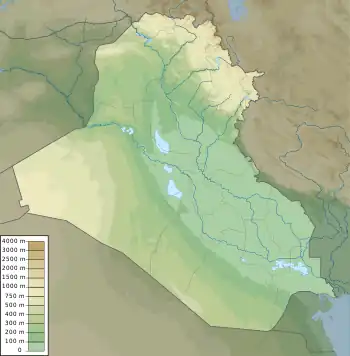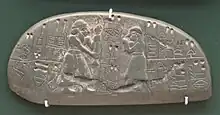Tell Uqair
Tell Uqair (Tell Uquair, Tell Aqair) is a tell or settlement mound northeast of Babylon and about 50 miles (80 km) south of Baghdad in modern Babil Governorate, Iraq.
Urum | |
 Shown within Iraq | |
| Alternative name | Tell Uquair, Tell Aqair |
|---|---|
| Location | Babil Governorate, Iraq |
| Region | Mesopotamia |
| Coordinates | 32°46′54″N 44°39′53″E |
| Type | tell |
| Site notes | |
| Excavation dates | 1941–1942 |
| Archaeologists | S. Lloyd, Taha Baqir, F. Safar |
Archaeology
Tell Uqair is a small mound just north of Tell Ibrahim, the large mound marking the site of ancient Kutha. The topography consists of two sub-mounds separated by what is apparently the bed of an ancient canal. At maximum the hills are 6 metres (20 ft) above the terrain line. The site of Tell Uqair was excavated during World War II, in 1941 and 1942, by an Iraqi Directorate General of Antiquities team led by Seton Lloyd, with Taha Baqir and Fuad Safar.[1] The buildings and artifacts discovered were primarily from the Ubaid period, the Uruk period, and the Jemdet Nasr period and included four Proto-Cuneiform tablets. A sounding was done by a team from the Heidelberg University in 1978.
History

The site of Tell Uqair first had significant occupation during the Ubaid period, and grew to its greatest extent during the Jemdet Nasr and Uruk periods. Some Early Dynastic graves and a scattering of Akkadian and Babylonian artifacts indicate the location continued in limited use up through the time of Nebuchadnezzar. Because of clay tablets found at the site, it is believed to be the ancient town of Urum.[2] The toponym for Urum is written in cuneiform as ÚR×Ú.KI (cuneiform: 𒌱𒆠), URUM4 = ÚR×ḪA (cuneiform: 𒌯), besides ÚR×A.ḪA.KI (cuneiform: 𒌬𒆠), from earlier (pre-Ur III) ÚR.A.ḪA.[3] It is known that during the 3rd millennium BC Urum was a cult site for the god Nanna.[4] It is also known that Urum was between the cities of Kish and Sippar, which fits with Tell Uqair, and that under the Ur III empire on of the ensi2 was one Ur-Sin.[5]
The most prominent discovery at Tell Uquair was the "Painted Temple", a large complex similar in design to the "White Temple" found at Uruk. Some of the original frescoes were still visible at the time of the excavation and were copied. Several frescoes were recovered intact and sent to the Baghdad Museum. The temple is believed to date to the Uruk or early Jemdet Nasr period. A small adjacent Jemdet Nasr temple was of somewhat later construction and contained large amounts of pottery from that period.[6]
It has been suggested, based on a topnym, that the Blau Monuments originated at Tell Uqair.[7]
See also
References
- Seton Lloyd and F. Safar, "Tell Uqair: Excavations by the Iraq Government Directorate General of Antiquities in 1940 and 1941", in: Journal of Near Eastern Studies, v. 2, no. 2, April, pp 131-58, 1943
- Robert K. Englund, "Proto-Cuneiform Texts from Diverse Collections", (Materialien Zu Den Fruhen Schriftzeugnissen Des Vorderen Ori), Gebr. Mann Verlag, 1996, ISBN 3-7861-1875-2
- Piotr Steinkeller, "On the Reading and Location of the Toponyms ÚR×Ú.KI and A.ḪA.KI", Journal of Cuneiform Studies, Vol. 32, No. 1, pp. 23–33, Jan. 1980
- Yuhong, Wu, and Stephanie Dalley, "The Origins of the Manana Dynasty at Kish, and the Assyrian King List", Iraq, vol. 52, pp. 159–65, 1990
- Sharlach, Tonia. "Princely Employments in the Reign of Shulgi", Journal of Ancient Near Eastern History, vol. 9, no. 1, pp. 1-68, 2022
- Dermech, S., "The Tell'Uqair temple (4th mill. BC): colours and iconography", In BAF-Online: Proceedings of the Berner Altorientalisches Forum (Vol. 1), 2016
- Balke, Thomas E., "The Interplay of Material, Text, and Iconography in Some of the Oldest “Legal” Documents", Materiality of Writing in Early Mesopotamia, edited by Thomas E. Balke and Christina Tsouparopoulou, Berlin, Boston: De Gruyter, 2016, pp. 73-94, 2016
Further reading
- Seton Lloyd, "Ur-Al `Ubaid, Uquair and Eridu, in Ur in Retrospect: In Memory of Sir Leonard Woolley", Iraq, vol. 22, pp. 23–31, 1960
- M. W. Green, "Urum and Uqair", Acta Sumerologica, vol. 8, pp.77–83, 1986
- Gilbert J. P. McEwan, "The Writing of Urum in Pre-Ur III Sources", Journal of Cuneiform Studies, Vol. 33, No. 1, pp. 56, Jan. 1981